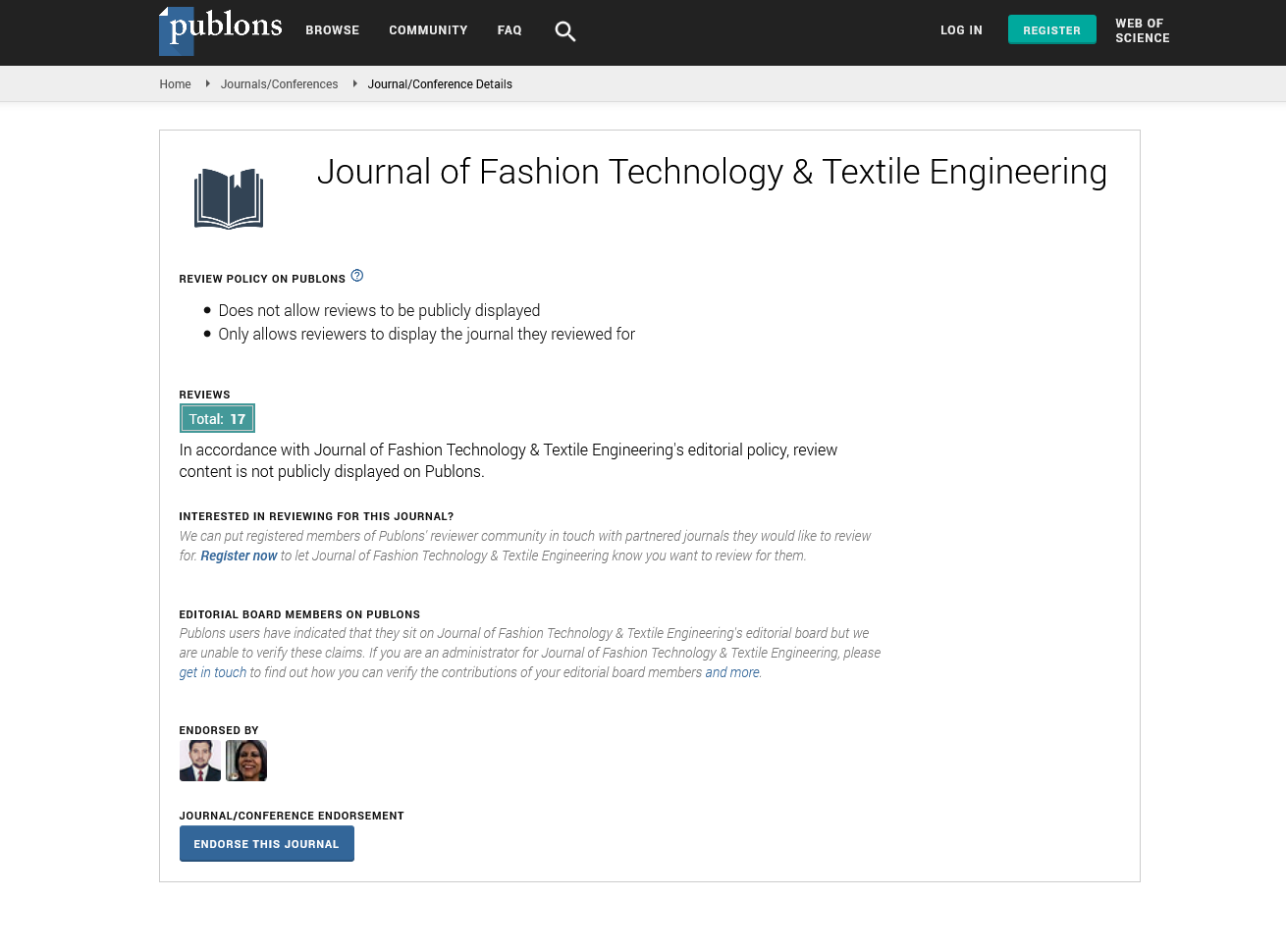Opinion Article, J Fashion Technol Textile Vol: 12 Issue: 5
Climate-Responsive Textiles: Designing for Environmental Adaptability
Isabella Rossi*
1Department of Fashion and Textile Engineering, National Cheng Kung University, Tainan, Taiwan
*Corresponding Author: Isabella Rossi,
Department of Fashion and Textile
Engineering, National Cheng Kung University, Tainan, Taiwan
E-mail: Isabella_rossi12@gmail.com
Received date: 23 September, 2024, Manuscript No. JFTTE-24-152101;
Editor assigned date: 25 September, 2024, PreQC No. JFTTE-24-152101 (PQ);
Reviewed date: 09 October, 2024, QC No. JFTTE-24-152101;
Revised date: 17 October, 2024, Manuscript No. JFTTE-24-152101 (R);
Published date: 25 October, 2024, DOI: 10.4172/2329-9568.1000377.
Citation: Rossi I (2024) Climate-Responsive Textiles: Designing for Environmental Adaptability. J Fashion Technol Textile 12:5.
Description
In a world facing environmental change, textiles that respond dynamically to surrounding climates are emerging as a favorable part of innovation. These fabrics go beyond simple weather resistance, adapting in real-time to fluctuations in temperature, humidity and UV exposure. By including materials that react to external stimuli, climate-responsive textiles aim to improve comfort, reduce the need for additional clothing layers and even minimize energy consumption. This approach could have implications for industries ranging from fashion to outdoor gear and beyond. Climate-responsive textiles use advanced fibers and techniques that change properties based on environmental factors. These fabrics often integrate materials such as Phase-Change Materials (PCMs) or Shape-Memory Polymers (SMPs), both of which respond actively to temperature shifts. PCMs, for instance, absorb and release heat based on ambient conditions, providing warmth when it's cold and cooling when temperatures rise. Meanwhile SMPs return to a pre-set shape in response to heat, providing flexibility and comfort to the wearer as conditions change. This adaptability makes climate-responsive textiles perfect for various climates and activities, from urban environments to extreme outdoor settings.
Humidity-responsive textiles are another approach in this domain, particularly useful in regions with fluctuating moisture levels. Certain textiles can expand, contract or ventilate in response to humidity, keeping the body dry and comfortable without compromising breathability. By reacting to sweat or environmental moisture, these fabrics support active lifestyles and reduce the likelihood of uncomfortable dampness or chafing. UV protection has also become a focus for these textiles, especially as people spend more time outdoors. Fabrics that can change in opacity or increase their UVblocking properties under intense sunlight provide a solution for protecting skin. Some textiles even incorporate dyes that activate under UV rays, changing color as an alert mechanism to remind users to apply sunscreen or search for shade. Such features can be particularly beneficial for children and those with sensitive skin, providing practical and visual signs for sun protection.
Beyond individual comfort, climate-responsive textiles may also have an impact on reducing energy consumption. By regulating body temperature more effectively, these fabrics reduce dependence on indoor heating or cooling systems. This flexibility can contribute to a reduction in overall energy use, benefiting both individuals and the larger community. For example, in colder environments, clothing made with climate-responsive textiles can maintain warmth without the bulk of traditional winter attire, reducing the energy costs associated with washing and drying heavy layers. Incorporating sustainability into these textiles is equally important. Many climateresponsive fabrics now use bio-based or recycled materials, minimizing environmental impact from production to disposal. The development of biodegradable responsive materials further advances these efforts, addressing concerns about plastic pollution from synthetic fabrics. By focusing on both environmental adaptability and ecological responsibility, climate-responsive textiles support a more sustainable future in the fashion and textile industries.
Conclusion
As research continues, wearable technology is finding its way into climate-responsive textiles as well. Sensors embedded in clothing can track environmental conditions and adjust fabric response accordingly. Smart jackets, for instance, may have small embedded systems that adjust warmth and ventilation as temperatures change. The integration of these smart elements also opens the door for feedback loops that allow wearers to personalize their clothing’s responses, creating a more interactive and customized experience. From urban settings to remote adventures, climate-responsive textiles provide a versatile solution for adapting to various environmental conditions. Through a blend of functional materials and thoughtful design, these textiles are not only enhancing personal comfort but are also moving towards a more sustainable future for clothing and accessories. As the world continues to face diverse climate challenges, climate-responsive textiles represent a practical and adaptable solution.
 Spanish
Spanish  Chinese
Chinese  Russian
Russian  German
German  French
French  Japanese
Japanese  Portuguese
Portuguese  Hindi
Hindi 


